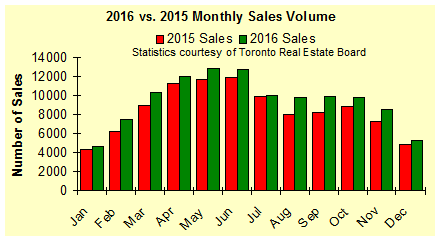Toronto Income Property Newsletter February 2017

The Toronto real estate market got off to a bit of a slow start this past January. There was very new little inventory in the GTA during the first couple of weeks and then more properties slowly started to pop up mid-month. Since there is so little for sale at the moment, everything is getting snapped up quickly, most times for considerably more than the asking price.
I expect income properties to be a challenge until more properties hit the market. The few that have sold downtown thus far have had cap rates in the threes and would have a hard time covering themselves without a sizable deposit. Remember that these are still supposed to be investments. Of course, the rental market remains strong. All indicators are that landlords on the whole won’t have difficulty renting their available suites for the foreseeable future.
February is Valentine’s month, so Happy Valentine’s to one and all. Let’s hope that this is the last of the cold and snow for this season.
- P.A.
Canada Capital Gains Exemption Rules
If you are like me and run a business from your home, there are several things you need to know if you ever decide to sell your home.
When a principal residence is sold, the gain is not taxable if it has been the person's principal residence for the whole time it has been owned. However, when a property use changes from personal-use to income producing, the deemed disposition can result in a capital gain. This is calculated by deducting the adjusted cost base of the property from the fair market value at the time of change in use. The fair market value at the time of change in use is the new adjusted cost base of the income-producing property. Note that if the property is not located in Canada, and the new adjusted cost base is over $100,000 in Canadian dollars, there will be a requirement to complete form T1135 foreign income verification statement each year in the future while the property is owned.
Any gain resulting from this deemed disposition may be eliminated by the principal residence exemption (PRE) if the property has always been the taxpayer's principal residence. If the property has been the principal residence for only a portion of the time it has been owned, then the gain could still be partially eliminated by the principal residence exemption. Starting with the 2016 taxation year, the disposition must be reported on the taxpayer's income tax return even if all the gain is exempt due to the PRE.
The taxpayer may also defer recognition of the resulting capital gain (if any) by electing under subsection 45(2) of the Income Tax Act to be deemed not to have made the change in use. This defers the recognition of the capital gain until the property is ultimately sold. This election cannot be made if there is only a partial change in use of the property. The election should be made when the change in use happens. Once this election has been made, the property can still qualify as the taxpayer's principal residence for up to 4 taxation years, even if the property is not inhabited during those years by the taxpayer. However, the taxpayer must still be a resident or deemed resident of Canada during those years to designate the property as the principal residence.

2016 Toronto Real Estate Market Stats
Although sales went down from November to December of last year, the number of sales were still higher than the previous year. The Toronto Real Estate Board reported 5,338 homes sold in December 2016. This December sales volume represents a 37% decline from the sales volume reported for November which is typical for the time of year but was 8.5 percent higher than the sales volume reported for December 2015.
Share this:
- Click to share on Facebook (Opens in new window)
- Click to share on Twitter (Opens in new window)
- Click to share on LinkedIn (Opens in new window)
- Click to share on Pinterest (Opens in new window)
- Click to share on Reddit (Opens in new window)
- Click to email a link to a friend (Opens in new window)
- Click to print (Opens in new window)


